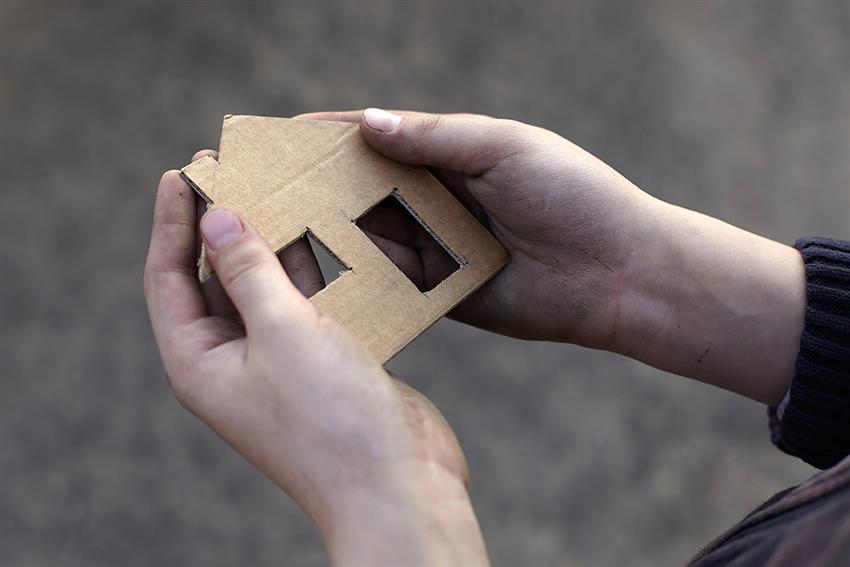
What thought do we, who curl up in a warm bed after a good meal and an evening watching our favourite TV shows in the comfort of our homes, give to those who have no home, or worse still, nowhere to sleep? How aware are we of the extent of homelessness in our own country?
What follows here is largely drawn from a simple Google search for ‘Homelessness in Australia’. Let’s then start with some facts from
Wikipedia.
There were 105,000 homeless people in Australia on the night of the 2011 census,
one in every 200 Australians. This was a 17% increase from the 2006 census. We will not know the extent of homelessness at the 2106 census until 2018.
Who are the homeless?
They are categorized as those living in:
- improvised dwellings, tents, sleepers out
- supported accommodation
- people staying with other households
- boarding houses
- other temporary lodgings
- severely overcrowded dwellings.
Almost 40% were in the last category. 6% were ‘sleeping rough’; it is a myth that most homeless people sleep on the streets.
To flesh these bare facts and figures out a little, many women, young people and families move from one refuge to another, or ‘couch surf’, or sleep in their cars, or live in cheap accommodation. Some live in severely overcrowded dwellings that fall well below basic community standards, such as boarding houses and caravan parks.
56% of the homeless were male, 44% female. 30% were born overseas.
Indigenous people made up 25% of the homeless, although they constitute only 2.5% of our population.
The age of homeless people extends across all age groups, but disturbingly 17% are under 12 and 42% are under 25. A few are over 75! It is a myth that most homeless are middle-aged men.
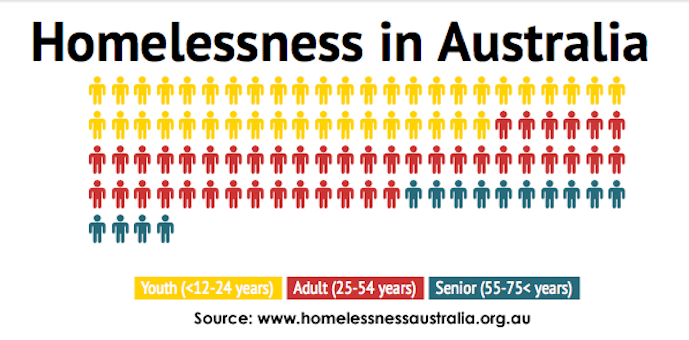
The causes of homelessness are myriad: unemployment, mental illness, financial troubles, drug or alcohol abuse, gambling, bereavement, loss of a job, and disability. Broken marriages and domestic violence often bring about homelessness. The homeless suffer poor health and isolation.
It is a myth that being homeless is a choice.
Domestic violence is one of the main reasons people seek help from a homeless service. Every week, women across Australia, often with children, escape abusive partners with nowhere to go and no other option.
There are some other myths that need dispelling: The following account of these myths and their rebuttal appears on the
Mission Australia website:
Homeless people just need to get a job:
The high cost of rental housing, particularly for low-income earners, forces many families and individuals out of their homes with no place else to live. Many of these people have a good education and jobs, but simply don't earn enough to cover rent and their basic needs. People whose physical or mental disability means they are unable to work, or who care for others, face additional barriers to finding suitable, affordable accommodation.
Homelessness is simply about physical housing and 'rooflessness':
Having a safe and secure place to sleep is vital to a person's health and wellbeing. For some people, finding somewhere to live that they can afford is all it takes to solve their homelessness. But for most, it takes more than that. They need assistance to gain life skills to be able to stand for themselves. Support such as financial advice, living skills training, mental health counselling, help in overcoming addictions, and job search assistance is crucial for people to break the cycle of homelessness and achieve independence.
Homelessness will never happen to me.
For thousands of Australians, the risk of losing their home is only one pay slip away. Factors such as sudden job loss, injury, illness, family breakdown or another unexpected disruption can affect anyone.
We will never solve homelessness.
Alarmingly, social and economic factors are contributing to more and more Australians facing the risk of homelessness. However, Mission Australia's work is making a big difference. In 2016, through our 62 homelessness and housing services we supported 18,529 people to get back on their feet and move towards rebuilding an independent life for themselves. By the community and governments working together, we can halve homelessness in Australia by 2025.
What can, what is being done to combat homelessness?
In our largest capital cities there has been a focus on ‘removing’ the homeless from Flinders Street or Martin Place, where they are seen as ‘an eyesore’. Every year executives ‘experience’ the discomfort of ‘sleeping rough’ when they curl up in their sleeping bags during a mid-winter night to ‘identify’ with street sleepers. It’s fine gesture, but how has it improved the lot of the homeless?
There’s a website:
Homeless in Australia – what is being done? that details some of the solutions:
- more low cost accommodation
- increased levels of support for people with a disability
- support for individuals as they negotiate the changing labour market
- greater access to family and relationship counselling
programs to reduce the levels of domestic violence and alcohol and other drug misuse within the community
- initiatives which build stronger communities so resources and networks are in place to support people in their community.
Thereafter follows a list of programs (Commonwealth, State and Local) that governments in Australia run and/or fund with a view to alleviating or preventing homelessness:
- The Supported Assistance Program (SAAP)
- The Commonwealth – State Housing Agreement and the Crisis Accomodation Program
- Rent Assistance (RA)
- The Emergency Relief Program (ERP)
- The National Homelessness Strategy
None of these were accessible online as the server could not be found!
We have to go overseas for inspiration.
Finland stands out among many European nations struggling with the problem of homelessness as one that has found a solution –
give the homeless a home!
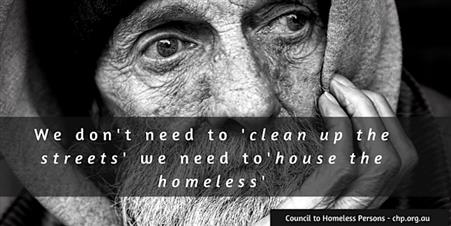
Here are some excerpts from an article about the Finnish solution in
The Guardian by Dawn Foster written in March of this year:
So how has the country done it? By giving homeless people permanent housing as soon as they become homeless, rather than muddling along with various services that may eventually result in an offer of accommodation.
We spoke to Juha Kaakinen, chief executive of the Y-Foundation, which provides 16,300 low cost flats to homeless people in Finland, to find out more:
What is Housing First?
Housing First means ending homelessness instead of managing it. The basic idea is to offer permanent housing and needs-based support for homeless people instead of temporary accommodation in hostels or in emergency shelters. Permanent housing means an independent rental flat with its own rental contract.
In Housing First people do not have to earn their right to housing by proving their capability to manage their lives. Instead, they are provided with a stable home and individually tailored support.
Also read: Homelessness and housing problems reach crisis point in all EU countries – except Finland.
How has it worked in Finland?
Since 2008 the national homelessness strategy in Finland has been based on the Housing First model, as a result of dedicated cooperation between the state, municipalities and NGOs.
Investments have been made to provide affordable housing and shelters have been converted into supported housing units. New services and methods of help have been developed to match the multiple needs of individual tenants.
Finland has all but eradicated rough sleeping and sustainably housed a significant number of long-term homeless people. Finland is the only country in Europe where the number of homeless people has declined in recent years.
What has the public response to Housing First been? Was there any backlash?
There was a strong political will to find new solutions for homelessness. There were a few local reactions concerning the location of new service facilities. However, those were mainly overcome by open interaction with the neighbourhoods.
Financially, how does Housing First work?
The key things are affordable housing and support. Extra funding that the state has allocated for flats and services has been an incentive for the municipalities to implement Housing First.
Tenants pay rent and are entitled to receive housing benefits. Depending on their income, they may contribute to the cost of the services. The rest is covered by the municipalities. They provide the support themselves or buy support from other service providers, mainly from the NGOs. Read more here.
Stable living conditions enable the use of mainstream services instead of using expensive emergency services. This will save money in a long term.
Were there any initial problems that needed to be ironed out?
The focus of the national strategy was clear from the start. The city specific implementation plans included concrete objectives and resources to meet them. Therefore, no major problems were encountered.
There was, however, some work to be done on attitudes. For example, the unconditional housing was hard to accept by some people in NGOs, which had previously been working with different a set of values.
How easily can the model be replicated in other European countries?
The Housing First model can be replicated even though housing conditions may vary from country to country in Europe. Providing permanent homes for the homeless should be a target instead of temporary solutions. There is no quick fix to all life situations but a solid base provides the foundations upon which to improve the welfare of the homeless. The first step in change is the change in attitudes.
How is it that Finland finds solutions to social problems as well as sustaining the best education system in Europe, possibly in the world?
Coming back to our own country
MashableAustralia lists
Eight incredible innovations helping homeless people around the world. You may care to glance through them.
Some are in place already here. In 2014 two young men instituted the
Orange Sky Laundry the world's first free mobile laundry service with two washing machines and two dryers in a van that wash and dry clothes for the homeless. Starting in the streets of Brisbane, Orange Sky has now grown to 20 services across Australia in Brisbane, Canberra, Gold Coast, Melbourne, Sydney, Sunshine Coast, North and South Perth, Adelaide, Newcastle, SE Melbourne, Wollongong, SA Northern Districts, Port Macquarie, Mackay and Hobart. Orange Sky Laundry now does over 6.2 tonnes of laundry every week. However, most importantly, it has over 1,300 hours of positive and genuine conversations with homeless people every week!
They have now introduced mobile Orange Sky Showers for the homeless.
Read about it here.
The comfort these homely amenities - clean clothes and a shower - have brought to countless homeless people is immeasurable. Their expressions of thanks are heart-rending.
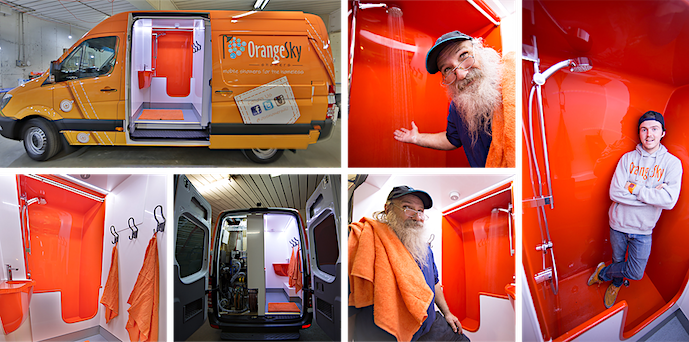
This piece could go on and on sketching what might be done for our own homeless. A poignant article in
The Sydney Morning Herald by Miichael Short:
How to fix homelessness: give the homeless a home? suggests several approaches. Do read it.
As a child who lived during the thirties, I saw homelessness in the raw as the Great Depression threw more and more out of work. Hungry, homeless men came to our back door in Nambour asking for money. My mother preferred to give them huge sandwiches. It was the spectre of these hapless souls that sparked my first notion of what job I would like to do: build houses for these homeless men - as it turns out, not a bad idea!
Yet here I am, all these years later, seeing the same iniquity of homelessness in our affluent country.
Will there ever be effective action in this lucky country to eliminate it?
Could we not be the Finland of the Southern Hemisphere?
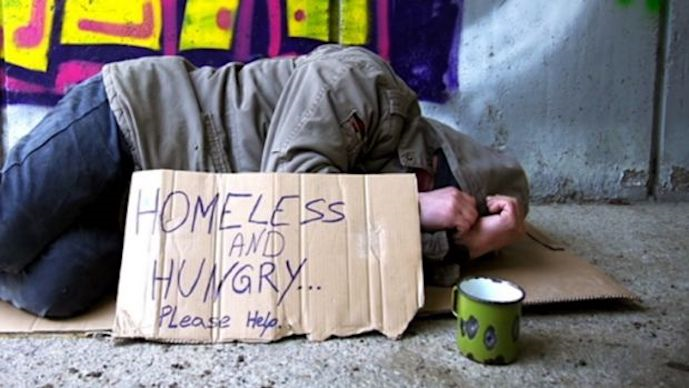
Current rating: 0 / 5 | Rated 0 times